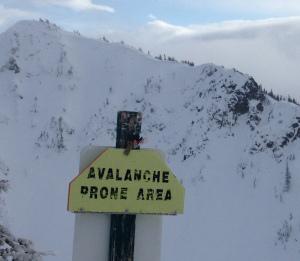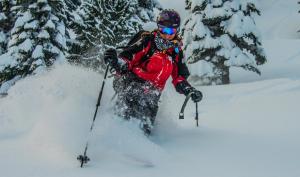
Avalanche Prone Area
The Cascade Mountains are in the midst of a major snow cycle. Pacific storms bringing wind and significant snowfall have pounded the Pacific Northwest mountains the past two weeks. As of yesterday, Crystal Mountain had received 40″ of snow in the past two days, and another 18-24″ is expected today. Another foot or two is on deck to Thursday.
Yesterday we posted signs at the ticket windows and the base of all chairs warning people of the hazards of deep snow. We recommend skiing with a partner and keeping them in sight at all times. We also recommend wearing a transceiver and carrying shovel and probe while in avalanche prone areas. Those areas at Crystal are specifically marked. Northway, Southback and Bear Pits are accessed through gates marked “Avalanche Prone Area”. And yet I’m surprised by how many people yesterday in Northway were not wearing transceivers yesterday.
Northway opened at 2pm yesterday after a full day of avalanche control. Moments before the gates opened, the lift went down for a mechanical reason. Eager powder hounds were amassing at the gates.

The Hike to Morning Glory looking back at Northway Notch yesterday
Ski patrol wanted to open the terrain in order to get tracks in there. Skier compaction is the best way to manage avalanche hazard. Ski and snowboard tracks today will keep the hazard lower tomorrow as new snow creates subsequent layers.
We decided to open “Short North”, asking people to return on I-5 rather than dropping down to the bottom. On a steep section of the horizontal return trail a small pocket of snow pulled out and buried a skier.

It was easy to get “gold fever” yesterday. Photo by Andrew Longstreth.
She was not wearing a transceiver. The snow carried her about thirty feet to a tree island where subsequent snow buried her. She was not tumbled or pushed very far. Luckily, she was able to punch one arm out of the debris and remove some of the snow near her airway and was therefore able to breath. After approximately 10 minutes, ski patrollers arrived, probed her and dug her out. She was okay, and able to return to the base area under her own power.
We can all learn many lessons from this close call.
- Wear a transceiver and know how to use it. Even when you aren’t planning on riding in an Avalanche Prone Area, wear it anyway. You just might be tempted to drop in when we open the gates.
- Ski with a partner. Keep this partner in sight the entire run. Plan your run ahead of time. Decide where you will stop and wait for the rest of your party. Make sure everyone is accounted for before continuing on.
- Ski one at a time. Do not drop onto a steep, deep slope with twenty other skiers and riders. Do not drop in above someone else. I know this seems like an impossible task. Often when we drop the gates everyone bum rushes the slope all at once even when we’ve warned them not to. Talk to the other people standing there and stake your lines beforehand.
- Carry a cellphone and put the ski patrol on speed dial. The emergency-only number is 360-663-3064. Witnesses at yesterday’s close call claim that it took a full five minutes before anyone called patrol.
- Carry a shovel and probe. Know how to quickly deploy them. Practice using them (and your beacon) at the Easy Searcher search park located next to the Campbell Basin Lodge.
It’s easy to get “gold fever” when standing at the top of a bottomless, untracked slope just as the sun peaks out. You feel like a hero. You feel lucky and blessed. And you are. Just remember to keep your brain screwed on straight. The best skiers and riders always do.

